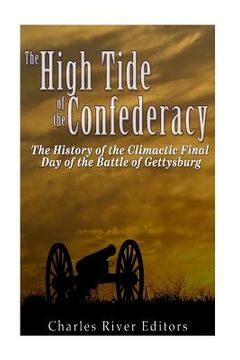The High Tide of the Confederacy: The History of the Climactic Final Day of the Battle of Gettysburg (en Inglés)
Reseña del libro "The High Tide of the Confederacy: The History of the Climactic Final Day of the Battle of Gettysburg (en Inglés)"
*Includes pictures *Includes accounts of the fighting written by soldiers and generals on both sides *Includes online resources and a bibliography for further reading *Includes a table of contents Without question, the most famous battle of the war took place outside of the small town of Gettysburg, Pennsylvania, which happened to be a transportation hub that served as the center of a wheel with several roads leading out to other Pennsylvanian towns. From July 1-3, Robert E. Lee's Confederate Army of Northern Virginia tried everything in its power to decisively defeat George Meade's Union Army of the Potomac, unleashing ferocious assaults that inflicted nearly 50,000 casualties in all. Day 1 of the battle would have been one of the 25 biggest battles of the Civil War itself, and it ended with a tactical Confederate victory, but over the next two days, Lee would try and fail to dislodge the Union army with attacks on both of its flanks during the second day and a massive attack against the center on the third and final day. Given that the Army of Northern Virginia would never muster another invasion of the North after Gettysburg, and the Confederates had mixed success the first two days of the battle, the third day is often remembered as the "high tide" or "high water mark" of the Confederacy, symbolizing its last real chance to win the war. As a result, the most famous attack of the Civil War was also one of its most fateful and fatal: Pickett's Charge, the climactic assault on the final day of the Battle of Gettysburg, which has become the American version of the Charge of the Light Brigade and one of the most famous events of the entire Civil War. The charge required marching across an open field for about a mile, with the Union artillery holding high ground on all sides of the incoming Confederates. Though it is now known as Pickett's Charge, named after division commander George Pickett, the assignment for the charge was given to General James Longstreet, whose 1st Corps included Pickett's division, and it included divisions from A.P. Hill's 3rd Corps. Longstreet had serious misgivings about Lee's plan and tried futilely to talk him out of it. Longstreet later wrote that he said to his commander, "General Lee, I have been a soldier all my life. It is my opinion that no fifteen thousand men ever arrayed for battle can take that position." Aware of the insanity of sending 15,000 men hurtling into all the Union artillery, Lee planned to use the Confederate artillery to try to knock out the Union artillery ahead of time. Although old friend William Pendleton was the artillery chief, the artillery cannonade would be supervised by Edward Porter Alexander, Longstreet's chief artillerist, who would have to give the go-ahead to the charging infantry because they were falling under Longstreet's command. Alexander later noted that Longstreet was so disturbed and dejected about ordering the attack that at one point he tried to make Alexander order the infantry forward, essentially doing Longstreet's dirty work for him. Unfortunately for Porter Alexander and the Confederates, the sheer number of cannons belched out so much smoke that they had trouble gauging how effective the shells were. As it turned out, most of the artillery was overshooting the target, landing in the rear of the Union line, which unnerved the Union soldiers but didn't rattle their defensive lines. Ironically, as the Union guns responded, they also overshot their target, but that meant they were frequently hitting the soldiers massed behind the Confederate artillery waiting to make the charge. As Longstreet and Alexander anticipated, the charge was an utter disaster, incurring a nearly 50% casualty rate and failing to break the Union line. After the South had lost the war, the importance of Gettysburg as one of the "high tide" marks of the Confederacy became apparent to everyone, making the battle all the more important in the years after.

